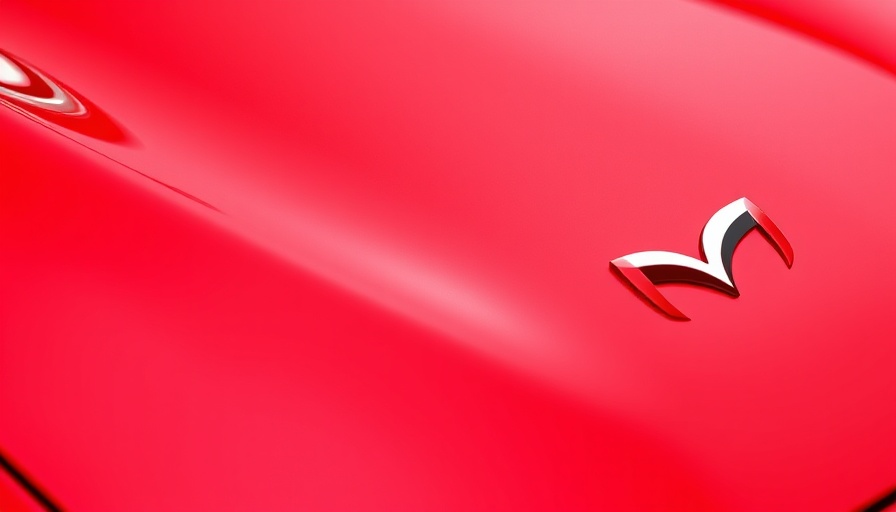
The Art Behind Mazda's Famous Soul Red Color
When you think of Mazda, one of the first things that comes to mind is its stunning Soul Red paint. This rich, vibrant hue has become an iconic representation of the brand, drawing car enthusiasts and casual drivers alike. But what many may not realize is that there's an intricate art process behind this vivid color, known as Takuminuri, which translates to "artisan coloring."
A Look at Takuminuri: More Than Just a Paint Process
Takuminuri is not simply a paint technique; it's a commitment to quality and craftsmanship that Mazda embodies. The process involves a novel approach to applying color, differentiating Mazda’s paint jobs from standard finishes. By utilizing smaller metallic flakes and multiple precise layers, Takuminuri creates depth and vibrancy that resonates with those who appreciate fine aesthetics in automotive design.
For instance, in a traditional method, larger flakes might be used, resulting in a more standard metallic look. However, Takuminuri layers include light-absorbing particles that enhance the visual experience, making the colors appear deeper and more luxurious—like that of a finely polished gem or a glass of rich red wine.
The Influence of Japanese Craftsmanship
Hiroshima, Japan, where Mazda was founded, has a rich tradition in arts like lacquerware, which directly influences their paint development. The laborious process of traditional lacquer work involves meticulous application and patience, much like the Takuminuri process. Keiichi Okamoto, Mazda’s design center head, draws inspiration from these age-old Japanese methods, proudly incorporating this artisanal spirit into Mazda's modern vehicles.
Okamoto's vision reminds us that a car’s color is more than just a superficial aspect; it plays a significant role in influencing perception and emotional response. The Soul Red aesthetic sparks feelings, much like cultural artifacts do, giving a sense of uniqueness and identity to each vehicle.
Engineering Precision Meets Artistic Vision
Takuminuri doesn’t just rely on artistry; it also embraces engineering excellence. To maintain consistency and perfection, Mazda employs advanced robot technology. These high-precision robots are programmed to apply each layer with meticulous accuracy, ensuring that drivers receive the flawless finish that is characteristic of Mazda vehicles.
This blend of artistry and technology speaks to the heart of Mazda's approach—where innovative solutions enhance traditional techniques rather than supplanting them. It’s a model for modern automotive craftsmanship, showing how a dose of tradition can elevate contemporary design.
Why Car Color Matters to Consumers
For many consumers, the color of a vehicle can significantly sway purchasing decisions. Soul Red, for instance, has often been noted for its ability to enhance the perceived value and attractiveness of the car. It evokes strong emotional responses, which contribute to brand loyalty. In practical terms, as vehicles are seen as personal statements, the color becomes a vital part of the consumer's identity.
Research shows that car colors can influence resale values and market desirability. As a result, Mazda's focus on creating distinct, vibrant colors aligns seamlessly with consumer preferences.
Future Trends in Automotive Color Innovations
The automotive industry is entering an age of exciting color innovation, largely influenced by customer demand for personalization and expression. Trends are evolving toward more diverse and custom finishes, with brands like Mazda leading the charge through processes such as Takuminuri that create eye-catching options for consumers. This push toward unique and vibrant colors suggests a broader industry acknowledgment of how integral color is to vehicle perception.
As technology advances, we can expect not only improvements in color application processes but also the potential emergence of interactive color technologies that could change how we view vehicle aesthetics in the future. Imagine cars that change color based on environment or mood—seems like something out of a sci-fi movie, doesn’t it?
Conclusion: Choosing What Resonates
Overall, Mazda’s approach to paint exemplifies how tradition, craftsmanship, and technology can come together to create something truly special. The Soul Red paint process is just one example of how crucial color is to the automotive experience.
As you consider your next vehicle purchase, think about how the color choices available can speak to your personality and preferences. Choosing a car is often about more than just function; it's a reflection of who you are, and Mazda’s stunning color offerings cater beautifully to that expressive desire. So next time you see a Soul Red Mazda on the road, remember, it’s more than just a color—it's a celebration of artistry, technology, and personal expression.
 Add Row
Add Row  Add
Add 




 Add Row
Add Row  Add
Add 

Write A Comment